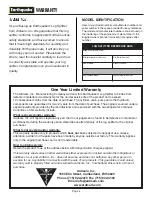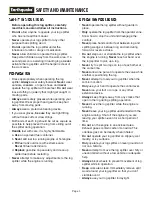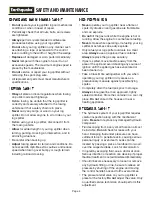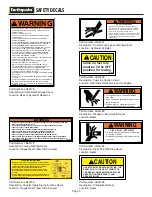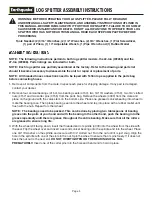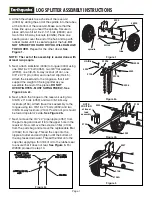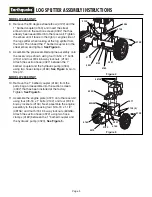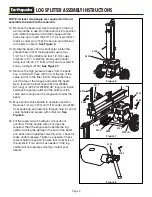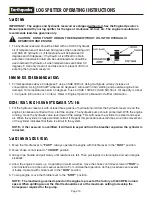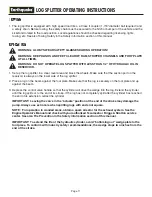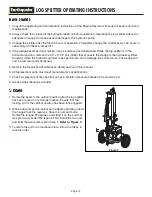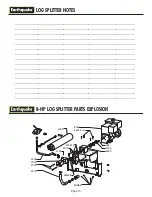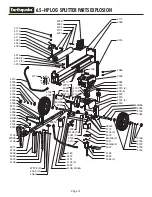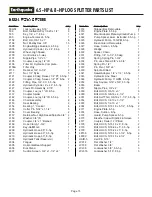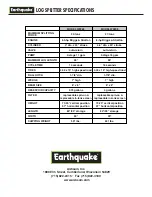
Page 4
REPAIR AND MAINTENANCE SAFETY
•
Do not
operate your log splitter in poor mechanical
condition or when in need of repair.
•
Periodically check that all nuts, bolts, and screws
are tightened.
•
Always
perform recommended maintenance
procedures before using your log splitter.
•
Do not
alter your log splitter in any manner such
as attaching a rope or extension to the control
lever or adding to the width or height of the wedge.
•
Replace
all damaged or worn parts immediately.
•
Never
tamper with the engine to have it run at
excessive speeds. The maximum engine speed is
preset by the manufacturer.
•
Do not
service or repair your log splitter without
removing the spark plug wire.
•
All replacement parts must meet manufacturer’s
specifications.
TOWING SAFETY
•
Obey
all state and local regulations when towing
on public roads and highways.
•
Before towing, be certain that the log splitter is
correctly and securely attached to the towing
vehicle and that a safety chain is in place.
•
Never
carry any cargo or wood on your log
splitter. Do not allow anyone to sit or ride on your
log splitter.
•
Before using your log splitter, disconnect it from
the towing vehicle.
•
Allow
for added length of your log splitter when
turning, parking, crossing an intersection, and in
all driving situations.
•
Be careful when backing up.
•
Adjust
towing speed for terrain and conditions. Do
not exceed 45 mph. Be extra cautious and reduce
speed when towing over bumpy or rough terrain
including railroad crossing.
FIRE PREVENTION
•
Never
operate your log splitter near a flame or
spark. Hydraulic oil and gasoline are flammable
and can explode.
•
Do not
fill the gas tank while the engine is hot or
running. Allow the engine to cool before refueling.
•
Never
smoke while operating or refueling your log
splitter. Gas fumes can easily explode.
•
Only refuel your log splitter outdoors in a clear
area.
Always
use an approved fuel container.
Always
replace the gas cap securely.
•
If gas is spilled, move machine away from the
area of the spill and avoid creating any source of
ignition until the spilled gas has evaporated or
been cleaned up.
•
Take a Class B fire extinguisher with you when
operating your log splitter in dry areas as a
precautionary measure against possible flying
sparks.
•
Completely drain the fuel tank prior to storage.
•
Always
store gasoline in an approved, tightly
sealed container. Store the container in a cool, dry
place.
Do not
store in the houses or near a
heating appliance.
HYDRAULIC SAFETY
•
The hydraulic system of your log splitter requires
careful inspection along with the mechanical
parts.
Be sure
to replace any damaged hydraulic
component.
•
Fluid escaping from a very small hole can almost
be invisible.
Do not
check for leaks with your
hand. Escaping fluid under pressure can have
sufficient force to penetrate skin, causing serious
personal injury or even death. Leaks can be
located by passing a piece of cardboard or wood
over the suspected leak. Look for discoloration.
•
If injured by escaping fluid, see a doctor at once.
Serious infection or reaction can develop if proper
medical treatment is not administered immediately.
•
Should it become necessary to loosen or remove
any hydraulic fitting or line, be sure to relieve all
pressure by shutting off the engine and moving
the control handle back and forth several times.
•
The pressure relief valve on your log splitter is
preset at the factory.
Do not
adjust the valve. Only
a qualified service technician should perform this
adjustment.
SAFETY AND MAINTENANCE


